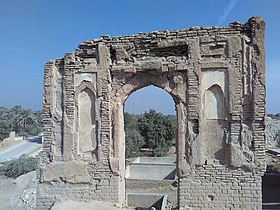أرور
أرور أو ألور[1] (بالسندية: اروهڙ) هي الاسم الذي كان يطلق في العصور الوسطى على مدينة روهري (في السند، باكستان حاليًا).[2][3] في الهند القديمة أرور كانت عاصمة لإقليم السند.[4] وتعرف هذه المدينة في المصادر الإسلامية بـ الراور.[5]
| أرور | |
|---|---|
 مسجد عالمكير القديم في أرور |
|
| تقسيم إداري | |
| البلد | |
| عاصمة لـ | |
| التقسيم الأعلى | السند |
| إحداثيات | 27°39′00″N 68°59′00″E / 27.65°N 68.9833°E |
 |
|
| تعديل مصدري - تعديل | |
تاريخ
عدلوباعتبارها رورُكا، عاصمة مملكة سووِيرا، فقد تم ذكرها كمركز تجاري مهم في الأدب البوذي المبكر.[6] وفي چچ نامه، لوحظ وجود أعضاء من جماعة البراهمة في مدينة أرور. لا يُعرف سوى القليل عن تاريخ المدينة قبل الغزو العربي في القرن الثامن الميلادي.[7] كانت أرور عاصمة مملكة راي ثم سلالة البراهمة التي حكمت شمال السند.[8]
في سنة 711م، سقطت مدينة أرور في قبضة جيش القائد الأموي محمد بن القاسم.[9] في سنة 962م تعرضت المدينة لزلزال هائل أدى إلى تغيير مجرى نهر السند وتدمير مباني المدينة المصنوعة من الطوب اللبن،[10] مما أدى إلى انحدار المدينة[11] وإعادة توطين السكان في روهري على طول شواطئ نهر السند الحديثة.[12]
أعلام
عدلالمراجع
عدل- ^ اختر حفیظ (5 يناير 2019). "اروڑ: سندھ کی قدیم تخت گاہ". داون نيوز (بالأوردية). مؤرشف من الأصل في 2022-10-02.
- ^ Malhotra، Anshu (2002). Gender, Caste, and Religious Identities: Restructuring Class in Colonial Punjab. Oxford University Press. ISBN:9780195656480. مؤرشف من الأصل في 2019-12-16. اطلع عليه بتاريخ 2014-10-08.
The Aroras were also said to be the Khatris of Arorkot, or Aror, the ancient capital of Sindh.
- ^ Singh، Kumar Suresh؛ Ghosh، Tapash Kumar؛ Nath، Surendra (1996). People of India: Delhi. Anthropological Survey of India. ISBN:9788173040962. مؤرشف من الأصل في 2020-01-11. اطلع عليه بتاريخ 2014-10-08.
The Arora or Rora is a community of traders of the south-western part of the Punjab. Their origin according to the Bhavishya Purana, can be traced back to the time of Parshuram, who in anger started killing the Kshatriyas. In this process, Parshuram met a Kshatriya who refused to oppose the Brahmans, and winning Parshuram's respect, was asked to go to Sindh to setde there. Later, the place came to be known as Arutkot or Arorkot. His progeny are called Aroras.
- ^ Handbook of the Punjab, Western Rajputana, Kashmir, and Upper Sindh. جون موراي . 1883. ص. 293. مؤرشف من الأصل في 2020-02-12. اطلع عليه بتاريخ 2014-10-08.
Aror.--While at Rorhi, a visit may be paid to the very ancient town of Aor, which is only 5 m. distant to the E. This was the capital of the Hindu Rajas of Sindh and was taken from them by the Muslims, under Muhammad Kasim, about 711 A.D. At that time the Indus washed the city of Aror, but it was diverted from it by an earthquake about 962 A.D., at which the river entered its present channel.
{{استشهاد بكتاب}}: صيانة الاستشهاد: علامات ترقيم زائدة (link) - ^ عيدروس، محمد حسن (15/11/2009). "الدولة الإسلامية الثالثة: الخلافة الأموية : أسرة أبو سفيان وأبو المروان الأموي". دار الكتاب الحديث، – عبر كتب جوجل.
{{استشهاد ويب}}: تحقق من التاريخ في:|تاريخ=(مساعدة) - ^ Derryl N. MacLean (1989), Religion and Society in Arab Sind, p.51,136 نسخة محفوظة 2023-08-12 على موقع واي باك مشين.
- ^ Hughes، Albert William (1876). A Gazetteer of the Province of Sind. G. Bell and Sons. ص. 677. اطلع عليه بتاريخ 2017-12-19.
aror .
- ^ MacLean، Derryl N. (1989). Religion and Society in Arab Sind. BRILL. ISBN:9004085513.
- ^ History of the Punjab, Volume 1 by Fauja Singh, Published by the Department of Punjab Historical Studies, Punjabi University, 1977
- ^ Rose، H. A [بالإنجليزية] (1911). A Glossary of The Tribes & Castes of The Punjab & North West Frontier Province. Lahore: Samuel T. Weston. ج. II. ص. 17. اطلع عليه بتاريخ 2011-10-24.
- ^ Bowden، Rob (2004). Settlements of the Indus River. Heinemann-Raintree Library. ISBN:1403457182. مؤرشف من الأصل في 2023-06-30. اطلع عليه بتاريخ 2017-12-19.
- ^ "Where the city of Aror once stood in glory". Dawn. مؤرشف من الأصل في 2018-08-09. اطلع عليه بتاريخ 2017-12-19.